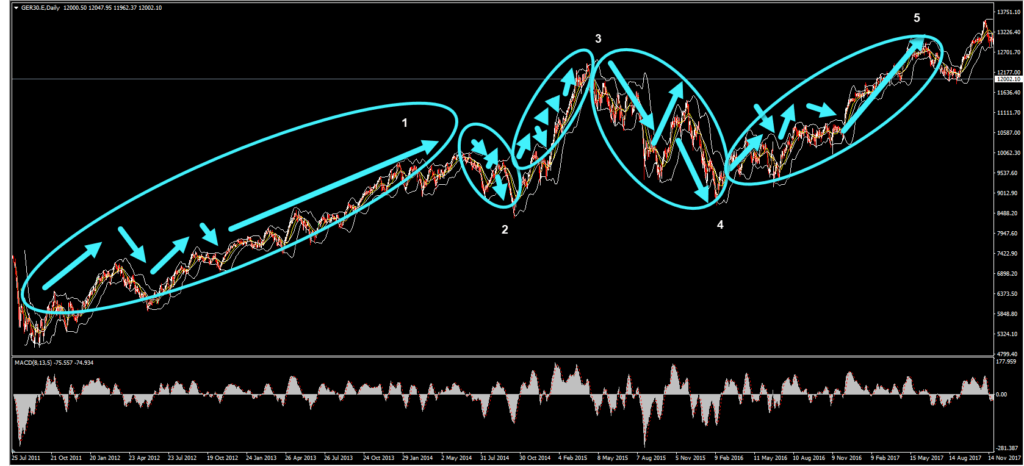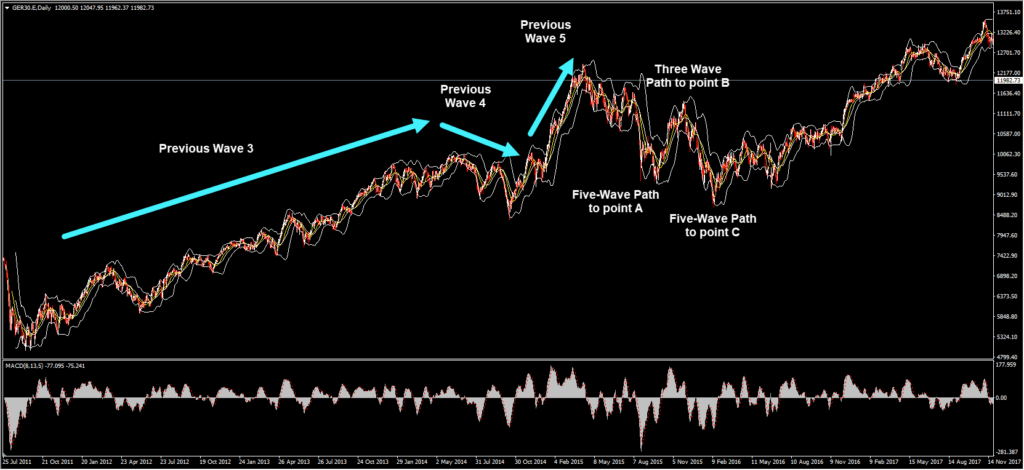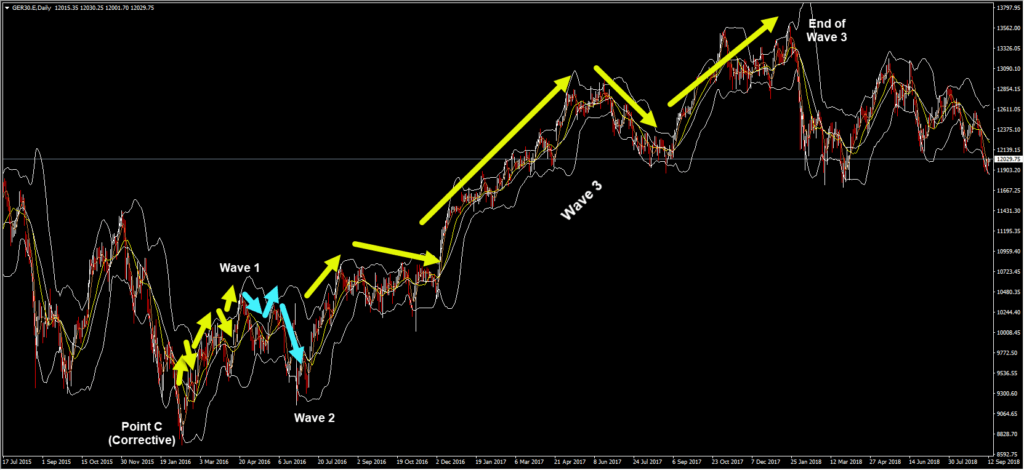GER30, D1
Last time we visited the Elliot Wave Theory (EWT), it suggested the presence of phase (v) in the first motive wave. Since then, it appears that the USA30 has still not moved over the 26149 resistance level and hence phase (v) appears to continue. Today we will deal with another index, namely GER30, which is also a good opportunity for study. In our analysis we employ daily data, which usually means that we are assessing the longer-term trend of the index. Still, the benefit of EWT is that it can be employed for higher frequencies hence there is practically no limit to its use.
To begin our analysis we first need to identify in which Wave and phase we are located. To this end, have a look at the figure below. Suppose that we interpreted the start of our sample as Wave 1. Remember that EWT stipulates that markets move in a 5-wave sequence, of which the second and fourth move against the long-term trend (correction wave). In other words, if the overall trend is upwards, the second and fourth wave will be moving downwards and vice versa. Within the waves themselves, there is a smaller 5-wave movement in Waves 1,3, and 5, while a 3-wave movement is observed for waves 2 and 4. Following this, we have identified that the Waves moved as indicated in the circles below. Is this correct?
Let’s examine for validility: can Wave 1 be the longest wave? In theory, yes albeit this is not very common. Can Wave 3 be the shortest though? That does not really abide with EWT. Furthermore, Wave 4 appears to overlap with Wave 1’s territory, another sign that our analysis does not abide the EWT rules. Let’s try to reassess the Waves now. As we have seen, the longest wave cannot be classified as Wave 1, and it is too long to be a correction wave so it’s either Wave 3 or 5. However, if it was classified as Wave 5, i.e. the end-wave of the series, the following corrective waves would have to end up lower and not higher than that. Hence, it can only be classified as Wave 3. The figure below presents how the waves would evolve.
The end of the corrective wave phase usually leads to new waves, which again have smaller 5-3-5-3-5 waves nested within them. The figure below illustrates just that, with yellow arrows indicating Waves 1 and 3 and the turquoise arrows suggesting Wave 2. The end of Wave 3 appears to have been in late-January 2018, following which, we should expect a downwards Wave 4, which should nest 3 smaller waves. Note that the Waves suggested abide by EWT rules given that Wave does not retract more than the beginning of Wave 1, while Wave 3 is definitely longer than Wave 1.
The end of Wave 3 suggests that a downwards adjustment should come next, however, one that should not overlap with the price territory of wave 1. The starting figure in this post shows just that, with a 3-wave movement indicating Wave 4. As EWT then suggests, a positive Wave 5 should be next in sequence. As such, there appears to be a Wave 5 formation which is currently at its second nested wave. Nonetheless, given that this phase is not yet over we need to identify the support and resistance levels. In particular, given that Wave 5 cannot really move past Wave 3 we have set the lowest limit at 11699. If the index breaks this support level then we may have to reassess our definitions regarding the waves. If we are correct, then we would have clear signals of a Wave 5 formation if it breaks the 13153 level, which coincides with the Fibonacci 76.4% level. The 76.4% level also abides by the EWT rules. Until then, we have also associated four more resistance levels, at Fib. 23.6% (12149), 38.2% (12426), 50% (12648) and 61.8% (12873). Remember that resistance levels become support levels once they have been surpassed and hence movement within a next level is to be expected. As always, bear in mind that “the market can remain irrational longer than you can remain solvent”. In this case, in order to confirm that a Wave 5 formation is present we may need to wait for a while. Hence proper risk management strategies is, and should be, always part of any trading strategy.
Disclaimer: Nothing in this communication contains, or should be considered as containing, an investment advice or an investment recommendation or a solicitation for the purpose of purchase or sale of any financial instrument.
Recommended Content
Editors’ Picks
USD/JPY jumps above 156.00 on BoJ's steady policy

USD/JPY has come under intense buying pressure, surging past 156.00 after the Bank of Japan kept the key rate unchanged but tweaked its policy statement. The BoJ maintained its fiscal year 2024 and 2025 core inflation forecasts, disappointing the Japanese Yen buyers.
AUD/USD consolidates gains above 0.6500 after Australian PPI data

AUD/USD is consolidating gains above 0.6500 in Asian trading on Friday. The pair capitalizes on an annual increase in Australian PPI data. Meanwhile, a softer US Dollar and improving market mood also underpin the Aussie ahead of the US PCE inflation data.
Gold price flatlines as traders look to US PCE Price Index for some meaningful impetus

Gold price lacks any firm intraday direction and is influenced by a combination of diverging forces. The weaker US GDP print and a rise in US inflation benefit the metal amid subdued USD demand. Hawkish Fed expectations cap the upside as traders await the release of the US PCE Price Index.
Stripe looks to bring back crypto payments as stablecoin market cap hits all-time high

Stripe announced on Thursday that it would add support for USDC stablecoin, as the stablecoin market exploded in March, according to reports by Cryptocompare.
US economy: Slower growth with stronger inflation

The US Dollar strengthened, and stocks fell after statistical data from the US. The focus was on the preliminary estimate of GDP for the first quarter. Annualised quarterly growth came in at just 1.6%, down from the 2.5% and 3.4% previously forecast.




